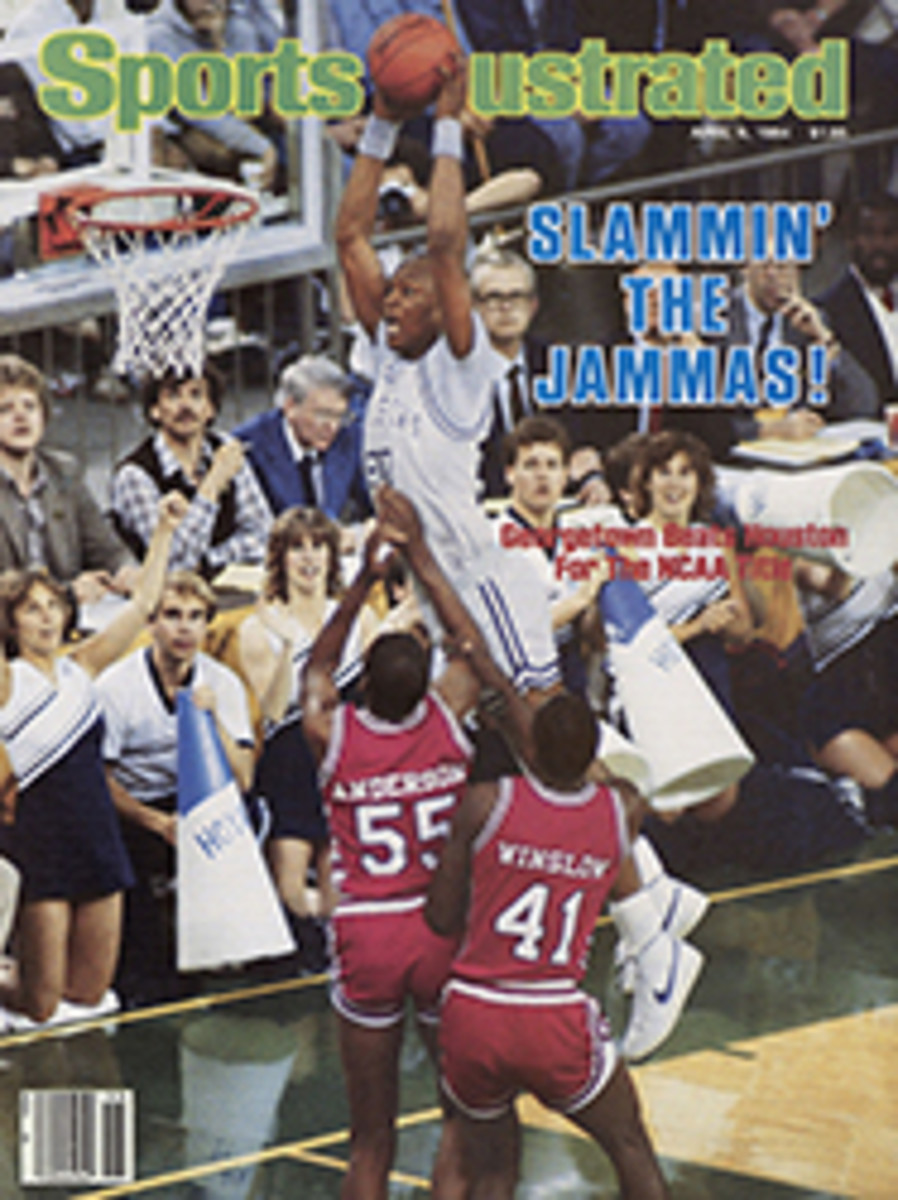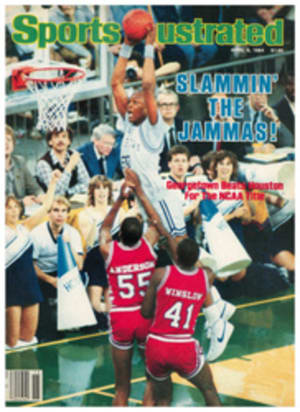
SCORECARD
HAVE THEY EVER
A final note from the World Cup ski circuit. As members of the U.S. women's team wended their way by car from Lake Placid to the next World Cup race site at Waterville Valley, N.H., they stopped for lunch at a restaurant in Hanover, N.H. named Peter Christian's Tavern. In their sweaters and jeans they looked not the least bit exotic—but there was that color. "Hey," said the waitress, not recognizing the likes of Olympians Cindy Nelson and Christin Cooper. "Great tans! You guys been skiing?"
THE UGLY OPEN
Eight members of the U.S. Olympic water polo team were recently treated to a whirlwind tour of Manhattan by one of the team's sponsors, Levi Strauss & Co. The athletes stayed at the Parker Meridien, met Gertrude Ederle, put on a demonstration at the New York University pool, held a press conference, ate dinner at the Sumptuary on the East Side and then hit some late-night spots for dancing. A splendid time was had by all.
Well, not quite all. In the interest of keeping the entourage to a manageable size for public-relations purposes, eight other members of the U.S. water polo squad, which is made up entirely of Californians, weren't included in the New York visit, and these unfortunate fellows weren't told exactly why they were spurned. But they quickly came to their own conclusions. "We figured they were taking only the good-looking guys East and leaving the ugly guys at home," said John Siman, a 31-year-old defenseman who didn't get to make the trip. "We figured we just weren't very good-looking dudes."
To pass the time while their teammates were enjoying themselves in the Big Apple, Siman and the other stay-at-homes decided to hold a golf tournament at a municipal course in Long Beach. They dubbed it the Ugly Open. Participants had to forswear shaving for three days before tee-off and were encouraged to wear their scruffiest golf garb. Jody Campbell, a two-meter man on the water polo team, showed up in a pair of plaid Bermuda shorts that were judged by acclamation to be the ugliest. Only ugly golf shots were applauded, and there were plenty of them. Defenseman Peter Campbell was the ugliest golfer, with a score of 122. The low score was Siman's ugly-enough 100.
A happy postscript. After their brief separation, the eight self-described uglies were reunited with their teammates for a 16-day playing tour of Europe, and Siman expressed confidence that bygones would be bygones. "The team can come together," he said. "I think we all realize there are more important things than looks."
BURSTING HIS BUBBLE
It happened during spring training at the Reds' camp in Tampa. The Topps baseball-card people were in town, and pitcher Mario Soto, who last year led the league in giving up homers, for some reason started picking out photos of players who had taken him deep.
"Mario," said Cincy vice-president Jim Ferguson, "who's going to help you carry them?"
WELL-COIFFED KID
On his radio call-in show, Indiana basketball coach Bobby Knight was asked by a young girl if the Hoosiers' star guard, Steve Alford, used anything to keep his hair so neatly in place during games Knight replied, "I think what he does, sweetheart, is put his hand on his hair to keep it in place when he should be applying defensive pressure."
PUTTING IN FOR OVERTIME
After operating without regular-season overtime for 41 years, the NHL swallowed hard and adopted a five-minute, sudden-death OT for the 1983-84 season. By the time the season ended, on Sunday, it was clear that the main argument that had long been used against overtime had proved, during this first season anyway, groundless. The fear had been that overtime would simply help the strong teams, and, indeed, Edmonton, the NHL's point leader for '83-84, had the best OT record (4-0-5) while the league's poor relations, Pittsburgh (1-5-6) and New Jersey (1-7-7), had two of the worst. But in between there were some surprises. Detroit general manager Jim Devellano was opposed to overtime, saying, "It stinks," yet the mediocre Red Wings' 3-1-7 OT mark tied them for fourth-best in the league with another sub-.500 team, St. Louis. Conversely, the mighty Islanders were tied for 11th at 3-3-4.
Another notion that wasn't borne out was that the introduction of overtime would raise the intensity of play in the third period, because teams wouldn't be satisfied to sit on a tie. But either that didn't happen or, more likely, the intensity of both teams increased more or less equally, because the number of games deadlocked at the end of regulation time actually increased—from 127 last season to 140 in '83-84.
But here's the key statistic. Whereas all 127 of last season's ties necessarily remained unresolved, only 86 of this season's 140 deadlocked-after-60-minutes games ended in ties; the other 54 games were settled excitingly by sudden-death goals. All of which moves the NHL closer to the position of Quebec Nordiques president Marcel Aubut, who's widely credited with having persuaded his fellow NHL brass to try overtime. "Sports should have a winner," says Aubut. "It's the essence of competition."
DOPE BOOK
The 1984 edition of the Official Baseball Dope Book is out, and its editor, Craig Carter, admits to some apprehensions about the title. Published since 1942 by The Sporting News, the book deals with a harmless form of "dope"—the sort of statistical arcana on which baseball devotees feast—but because of recent headlines linking the national pastime to illicit drugs, some fans, finding irony in the word, have mischievously written in suggesting that Carter put one or another of the ballplayers who've gotten in trouble with drugs on the cover. In fact, two players who've been implicated in drug cases, Vida Blue and Ferguson Jenkins, were pictured on inside covers of past editions of the Dope Book, but in both instances well before their drug involvement became known. Carter concedes that if a player got in trouble with drugs at the same time he happened to be on the Dope Book's cover, the resulting embarrassment conceivably "could be the cause of our having to change our name."
So, who's on the cover of the 1984 Dope Book? It's the White Sox' LaMarr Hoyt, who was chosen for the honor strictly on the basis of his performance as last year's American League Cy Young Award winner. No double meaning there at all.
"THE COLTS WERE OURS.... THEY WERE ONE WITH THE CITY"
When owner Robert Irsay moved the Baltimore Colts to Indianapolis last week, the news accounts concentrated on the fact that he did so unannounced, late on a stormy night when a fleet of moving vans picked up the club's possessions at its suburban Baltimore headquarters. But as senior writer Frank Deford, a native son, makes clear, Irsay's treachery wouldn't have been appreciated in Baltimore under any circumstances. Deford writes:
I grew up in Baltimore, with the Colts, and I know just how much they meant to that working-class city, forever in the lee of Washington and New York. The Colts were ours—even more so than the baseball team that came to town about the same time. Its very name, Orioles, belonged to another time, that of our grandfathers. The Colts were one with the city. It's really quite amazing. A man who could screw up professional football in Baltimore would foul the water at Lourdes or flatten the beer in Munich.
It was only a couple of weeks ago that I was talking to Alex Hawkins, old Captain Who of so many Colt special teams. Alex told me how every fall, when he would come back to Baltimore from Atlanta, where he lived, he would purposely move into a different part of town because Baltimore was a city of neighborhoods and all that the citizens really asked of any Colt was that he drink with them in a neighborhood bar. Why, just down from where I grew up there was Mose's Sunoco station, where some of the Colts actually hung out after practice, kicking tires and all. There wasn't a person in Baltimore who didn't know at least one girl who was going out with a Colt. The Colts were like a high school team for a city of a million people.
The two most exciting franchises in sports at that time were the Milwaukee Braves and the Colts. Baltimore, you see, was the first place pro football mania really surfaced. It was 20 years ahead of old fancy-pants Washington, which still acts like it discovered enthusiasm. Impressionable youth that I was, I was so awed by Colt madness that I wrote my first novel about it. The plot had to do with how a guy who chanced upon some Colt season tickets got to be mayor. Then, one of my Baltimore contemporaries, Barry Levinson, brought out the movie Diner. Remember that? The girl Eddie wanted to marry had to pass a test about the Colts before he would walk down the aisle with her. People said, "Boy, was that far out!" I said, "No." Having grown up in Baltimore, I thought it was very true to life. Besides, it was an easy test Eddie gave her. Sample question: What was the longest run from scrimmage by a Colt rookie in his first game? Alan Ameche's 79-yarder on opening day in 1955, of course.
Here's another Colt question: In what cities did the Colt franchise fail before it came to Baltimore? Answer: New York and Dallas. Imagine that, Baltimore supporting a football team when New York and Dallas couldn't! Look it up. And now, just because some egomaniacal carpetbagger named Irsay needs to cover his mistakes, the Colts leave Baltimore under cover of darkness. Of course, it's much easier now for the modern highwaymen who own sports franchises to use up cities and throw them away. Thanks to the antitrust laws, they don't have to ask for anybody's permission; all they need is a credit card to get a moving van in.
One last thing. If some future Eddie gives a test to his beloved, and the question is when did the Baltimore Colts die, the correct answer isn't 1984 but 1972, for that was when the NFL allowed a man like Irsay to buy a city's heart. The Baltimore Colts have been playing games all these years since then, but they've been brain dead.
PHOTO
ILLUSTRATION
THEY SAID IT
•Gene Shue, Washington Bullets coach, commenting on star center Jeff Ruland: "Without him we're an average team. In fact, with him we're an average team."
•Steve Garvey, San Diego Padre first baseman, who missed the final 62 games of last season with a thumb injury: "I have just one goal: to be thumb-back player of the year."

